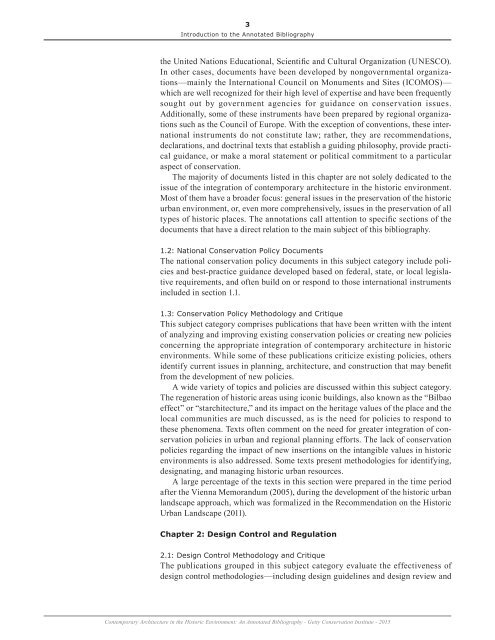Contemporary Architecture in the Historic Environment
cahe_bibliography
cahe_bibliography
Create successful ePaper yourself
Turn your PDF publications into a flip-book with our unique Google optimized e-Paper software.
3<br />
Introduction to <strong>the</strong> Annotated Bibliography<br />
<strong>the</strong> United Nations Educational, Scientific and Cultural Organization (UNESCO).<br />
In o<strong>the</strong>r cases, documents have been developed by nongovernmental organizations—ma<strong>in</strong>ly<br />
<strong>the</strong> International Council on Monuments and Sites (ICOMOS)—<br />
which are well recognized for <strong>the</strong>ir high level of expertise and have been frequently<br />
sought out by government agencies for guidance on conservation issues.<br />
Additionally, some of <strong>the</strong>se <strong>in</strong>struments have been prepared by regional organizations<br />
such as <strong>the</strong> Council of Europe. With <strong>the</strong> exception of conventions, <strong>the</strong>se <strong>in</strong>ternational<br />
<strong>in</strong>struments do not constitute law; ra<strong>the</strong>r, <strong>the</strong>y are recommendations,<br />
declarations, and doctr<strong>in</strong>al texts that establish a guid<strong>in</strong>g philosophy, provide practical<br />
guidance, or make a moral statement or political commitment to a particular<br />
aspect of conservation.<br />
The majority of documents listed <strong>in</strong> this chapter are not solely dedicated to <strong>the</strong><br />
issue of <strong>the</strong> <strong>in</strong>tegration of contemporary architecture <strong>in</strong> <strong>the</strong> historic environment.<br />
Most of <strong>the</strong>m have a broader focus: general issues <strong>in</strong> <strong>the</strong> preservation of <strong>the</strong> historic<br />
urban environment, or, even more comprehensively, issues <strong>in</strong> <strong>the</strong> preservation of all<br />
types of historic places. The annotations call attention to specific sections of <strong>the</strong><br />
documents that have a direct relation to <strong>the</strong> ma<strong>in</strong> subject of this bibliography.<br />
1.2: National Conservation Policy Documents<br />
The national conservation policy documents <strong>in</strong> this subject category <strong>in</strong>clude policies<br />
and best-practice guidance developed based on federal, state, or local legislative<br />
requirements, and often build on or respond to those <strong>in</strong>ternational <strong>in</strong>struments<br />
<strong>in</strong>cluded <strong>in</strong> section 1.1.<br />
1.3: Conservation Policy Methodology and Critique<br />
This subject category comprises publications that have been written with <strong>the</strong> <strong>in</strong>tent<br />
of analyz<strong>in</strong>g and improv<strong>in</strong>g exist<strong>in</strong>g conservation policies or creat<strong>in</strong>g new policies<br />
concern<strong>in</strong>g <strong>the</strong> appropriate <strong>in</strong>tegration of contemporary architecture <strong>in</strong> historic<br />
environments. While some of <strong>the</strong>se publications criticize exist<strong>in</strong>g policies, o<strong>the</strong>rs<br />
identify current issues <strong>in</strong> plann<strong>in</strong>g, architecture, and construction that may benefit<br />
from <strong>the</strong> development of new policies.<br />
A wide variety of topics and policies are discussed with<strong>in</strong> this subject category.<br />
The regeneration of historic areas us<strong>in</strong>g iconic build<strong>in</strong>gs, also known as <strong>the</strong> “Bilbao<br />
effect” or “starchitecture,” and its impact on <strong>the</strong> heritage values of <strong>the</strong> place and <strong>the</strong><br />
local communities are much discussed, as is <strong>the</strong> need for policies to respond to<br />
<strong>the</strong>se phenomena. Texts often comment on <strong>the</strong> need for greater <strong>in</strong>tegration of conservation<br />
policies <strong>in</strong> urban and regional plann<strong>in</strong>g efforts. The lack of conservation<br />
policies regard<strong>in</strong>g <strong>the</strong> impact of new <strong>in</strong>sertions on <strong>the</strong> <strong>in</strong>tangible values <strong>in</strong> historic<br />
environments is also addressed. Some texts present methodologies for identify<strong>in</strong>g,<br />
designat<strong>in</strong>g, and manag<strong>in</strong>g historic urban resources.<br />
A large percentage of <strong>the</strong> texts <strong>in</strong> this section were prepared <strong>in</strong> <strong>the</strong> time period<br />
after <strong>the</strong> Vienna Memorandum (2005), dur<strong>in</strong>g <strong>the</strong> development of <strong>the</strong> historic urban<br />
landscape approach, which was formalized <strong>in</strong> <strong>the</strong> Recommendation on <strong>the</strong> <strong>Historic</strong><br />
Urban Landscape (2011).<br />
Chapter 2: Design Control and Regulation<br />
2.1: Design Control Methodology and Critique<br />
The publications grouped <strong>in</strong> this subject category evaluate <strong>the</strong> effectiveness of<br />
design control methodologies—<strong>in</strong>clud<strong>in</strong>g design guidel<strong>in</strong>es and design review and<br />
<strong>Contemporary</strong> <strong>Architecture</strong> <strong>in</strong> <strong>the</strong> <strong>Historic</strong> <strong>Environment</strong>: An Annotated Bibliography - Getty Conservation Institute - 2015
















